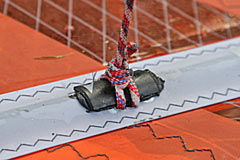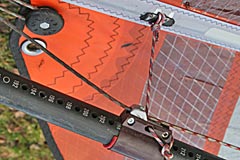|
Sunday the 8th March '09:
It's not the intention to make frequent reports from testing this flaps-up strings thing. However, the first sailing with the tentative setup wasn't exactly disappointing.
Sailing 2 smaller sessions with a NP RSR 10.7 on a Gaastra Vapor Formula and a NP RSR 9.0 on a Tabou Manta 85 I ran into shorter periods with strong winds. And taking into consideration that the temperatures are still a little winter like at my place (cold air strengthens the pulling effect in the sails considerably) the sails seemed to be more stable than usual – and seemed to convert the gusts to speed for a longer time before being back hand heavy. However, I didn't sail close to the other guys on the water today, so unfortunately it was impossible to compare ...
The strings on the 10.7 were tied, so that they pulled the batten 2 cm closer to the boom, when the outhaul was comparably slackened. As for the 9.0 the strings were tied in a more intuitive way, so that the strings just seemed to pull in the batten in the right way. Both methods functioned OK, and the effect seemed to work symmetrically on both tacks.
When sailing, the visual S-shape was pretty pronounced, especially when the sails were loaded up and outhauled (as predicted). On the 10.7 sail the S-shaping effect on the cross batten clearly affected the two battens above, and on the 9.0 sail the effect was at least clearly recognizable on the first batten above the cross batten.
In fact the S-shape/batten locking effect was so obvious, that perhaps it should be considered ...
1) to move the fixation point on the cross batten a little further back toward the leech, and
2) not to tie the strings too tight. If (very convenient for reasons of reproduction!) the strings are tied, so that they barely pull the batten closer to the boom, when the outhaul is comparably slackened, there's still room for inducing a little S-shape when the the sail are loaded. And when the wind rises - and you consequently operate the outhaul - the S-shape of course gets more pronounced. Without knowing, I got the feeling, that the objective with fiddling with the strings is to attain to a compromise, where the S-shape is somewhat restricted in low winds to obtain low end pull/early planing and ability to go close to the wind - and where the S-shape is pretty pronounced in stronger winds to obtain stability and speed.
Please have in mind that the temptation to give a positive evaluation might have been too overwhelming. I've tried to resist, but this report might be biased.
One last thing:
|
|
|
It's probably not necessary – but to avoid to point-load the fixation points on cross battens too much, they were strengthened a little (by means of small pieces of carbon (quarter sections from the end of a boom), which were glued on the batten pockets).
Click the picture to enlarge. |
|
|
To have the fixation points of the boom and the batten approx. in level it might be preferable to fixate the strings on top of the boom tubes. Here I've used the devices, that are primarily used to guide the outhaul lines along the tubes - but of course there are lots of other ways (if it's necessary at all).
Click the picture to enlarge. |
|

